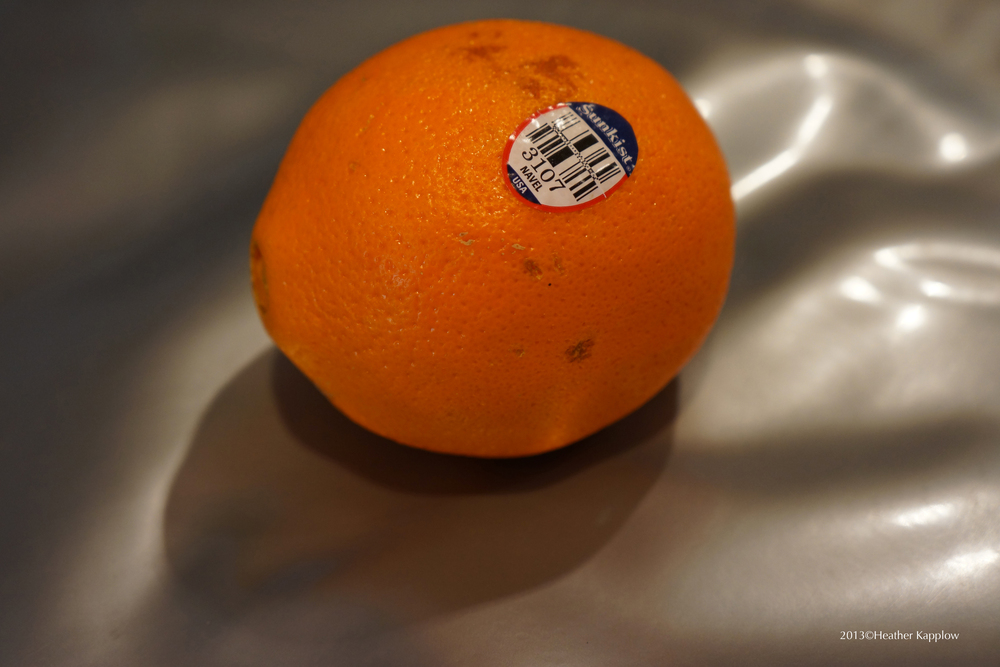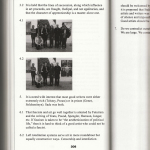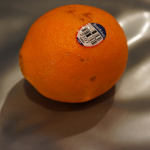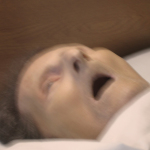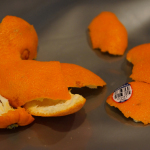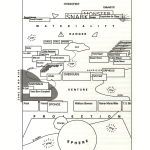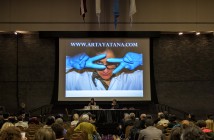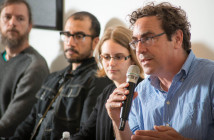I could (and maybe should) stop here but won't. Instead, I will offer a comprehensive list, in order and form of appearance, of artists, writers, inventors, military heroes, astronauts, filmmakers, mathematicians, philosophers, spiritualists, political figures, surfers, fives players, sailors, film stars and ex-roommates referenced in the first 100 pages of The Mattering of Matter.2 The first 100 pages of The Mattering of Matter are the least dense.
André Breton; Andrei Tarkovsky; Michel Leiris; Henri Michaux; Jean Cocteau; William S. Burroughs; Fyodor Dostoyevsky; Philip K. Dick; Jacques Lacan; Duchamp; Jackson Pollock; Fluxus; Konstantin Raudive; Thomas Edison; William O'Neil; Sarah Estep; Maurice Blanchot; Robert Louis Stevenson; Neil Armstrong; James Joyce; Vermeer; Fragonard; Beckett; Mondrian; Jacques Derrida; George Bataille; Pierre Klossowski; Roger Callios; Gérard de Nerval; Georg Cantor; Friedrich Nietzsche; Marcel Proust; Paul Valéry; Rirkrit Tiravanija; Jorge Luis Borges; Emanuel Swedenborg; William Blake; Shane Brighton; Rod Dickinson; Alistair Gentry; Nandita Ghose; Margarita Gluzberg; Sophy Griffiths; Isabel Rocamora; Alexander Hamilton; Sally Hampson; Stuart Home; Rut Blees Luxemburg; Melissa McCarthy; Luke McKeown; Matt Parker; Paul Perry; Ricky Seabra; Will Self; Mark Aerial Waller; Descartes; Schlegel; Richard Rorty; Turgenev; Kropotkin; Bakunin; Chernyshevsky; Lenin; Vico; Heine; Kant; Hegel; Theodor W. Adorno; Kojève; Marquis deSade; Francis Ponge; Wallace Stevens; Rilke; Wim Wenders; Wordsworth; Zygmunt Bauman; Fackenheim; Lanzmann; Sophocles; Swift; Buster Keaton; Hemingway; Heidegger; Schlageter; Charles de Gaulle; Shaftsbury; Diderot; Georg Lukács; Benjamin; Flaubert; Plato; Faulkner; Aeschylus; F.T. Marinetti; Captain Cook; Andy Martin; Keif Hillsbery; Lew Boren; Mark Foo; William Hazlitt; John Cavanagh; Jules Verne; Napoleon; Bridgitte Bardot; Joe Wolfson; Duke Kahanamoku; Melville; Richardson; Virilio; John Hinckley, Jr.; Euripides; Patty; Bachelard; Peter Benchley; Reagan.
A completely valid reading of The Mattering of Matter could probably be obtained by collecting all of the names dropped throughout and Googling them—reading Wikipedia entries where they exist perhaps creating any that don't exist for the next reader who attempts this method—and trying to determine what they share in common besides being cited in this book. I might also recommend integrating a drinking game into this process.
Another reading of The Mattering of Matter involves locating and decrypting a collection of words and phrases spattered across the text that are highlighted in gray blocks. These are annotations by the publisher, drawing attention to lapses in citation and other silences on the part of the authors. But the publisher also makes claims of agency within the International Necronautical Society (INS), so the possibility of buried treasure cannot be ruled out. Here is a selection of twelve gray-blocked phrases that I enjoyed in particular: "Klebb"; "upon your travels. You must"; "forthcoming"; "soccer"; "Vladislav Volkov, Georgi Dobrovolski, and Viktor Patsayev"; "mean"; "Ibid., 18, 81."; "shrouded in"; "must"; "in and out open windows, through walls, over courtyards"; "I knew that I was watching television.";"Ibid., 181." Make of them what you will.
My personal reading of The Mattering of Matter required me to sleep with an orange under my pillow from February 15, 2013 until March 1, 2013. The UPC sticker on this orange bears the number 3107 and the word "navel" (which can be interchanged with the word "naval" in spoken English without anyone batting an eye). On Wednesday, February 27, 2013 at 11:49am, EST, when it was documented for the purposes of this article, the orange was beginning to show some symptoms of its death. (When does an orange die? When it is picked? When it has rotted?)
While it was entombed beneath my pillow, I had a very vivid dream about my father, who died about six months ago. In the dream, instead of being buried, his body had been left on a gurney in a hallway in a nursing home by mistake. When I arrived on the scene to deal with the issue, it turned out that he was not entirely dead, even though his body had begun to decompose a bit. The nursing home had dispensed with his care because he was considered deceased at an official level and therefore no longer eligible for health insurance. So I took on the task of cleaning him and turning him in his gurney-bed, fixing his skin in place as best as I could, while awaiting assistance from the funeral home that had accidentally left him in the hallway. At some point, he died much more deeply—maybe even completely—and trails of smoke were emitted from his forehead when this happened. In reality, his body is in a fiberboard box, in a cement box, in the ground at a military cemetery. Was I getting smoke signals from "beyond" via the dream and the orange?
During the time that the orange was beneath my pillow, I also had a dream containing a motif that is a recurring one for me: I am in a room where the ceiling and walls are saturated with moisture. It drips. I can see the moisture seeping through the surfaces of the walls and ceiling. The solid matter of the room that I am in reveals its porousness. It is like a sponge. When I dreamed it this time, I woke up to pouring rain outside. I wonder if this is what it's like in a grave when it rains outside. Porous. Pour us. Poor us. In any case, between the death and the water, the orange brought on some very necronautical thoughts. The picture might be completed if I were to interpret the number 3107. I know already that it is not an insignificant number, but will leave it to the reader to identify its value in this context.
You are supposed to do this at the beginning of a piece of writing rather than in the middle, but I am imperfect. Disclosure: I have been an official agent of the International Necronautical Society since at least 2006, when my Facebook profile was created including this credential.
Necronauts are concerned with death and money (but not necessarily taxes); with navigation of the air, sea, and trauma; with mapmaking and code breaking; with craft, tape loops, and radio transmissions of various types; with data gathering, aerial performance and ethics; with environmental engineering and (to a certain degree not articulated within the manuscripts collected here) with the development, manufacture and distribution of pharmaceuticals. The main thing that necronauts are not concerned with is the future, which they see as immaterial. They are also unconcerned with fascism and copyright infringement.
So what is the significance of this book? It may not have any. Then again, it may mark the beginning—or rather the middle—of a major artmaking and curatorial movement. One whose esthetic is both serious and crude, whose process is at once intellectually rigorous and completely intuitive. Or many movements, spreading out like an infestation of ants to investigate any available sugar-coating on the world around them.
In purely etymological terms, the book announces the presence of at least a handful of travelers among us—members of the larger "us"—who awaken from sleep periodically to find themselves paddling through the muck of reality on personalized, buoyant caskets, taking water samples for analysis (or psychotropic stimulation) at every turn. In entomological terms, researchers find that the mosquitos known for transmitting yellow and dengue fevers develop a tolerance to DEET after their first exposure. In English, the necronautical collides or elides with the etymological (and perhaps also the pharmaceutical) at the intersection of "capsid" and "capsized." One derives from the Latin for "box" or "case", the other from the Latin for "head." Do they merge on collision or elision, arriving at "box head" or "head case?" Or do they just constantly reconstitute each other, mind and matter, minding and mattering, like waves breaking on the surface of an eternally dark sea?
I don't have an answer to this question yet, after only one reading through of The Mattering of Matter. But I do have a metaphor for the problem it presents to be (always) re-resolved by art. In the debate that spans back to at least Plato about the value of an ideal version of a thing versus the value of the thing sitting right in front of you, I think this collection of documents introduces the peal of a bell. (Do you hear it in your mind when I write that, "the peal of a bell"? If you do, I'd bet you anything that you hear it differently than I do, and that whatever bell either one of us hears next in our lived-lives—don't forget to listen for your personal next bell now, so that you can make a usable comparison!—will sound completely different than what either of us just imagined.) What's being introduced by the INS is neither the Platonic bell, nor the doorbell or trolley bell or church bell you'll hear at some point later this week. It's the bell referred to by Lewis Carroll, as quoted by Tom McCarthy on page 133 of The Mattering of Matter:
Other maps are such shapes, with their islands and capes!
But we've got our brave Captain to thank
That he's brought us the best—
A perfect and absolute blank!
This was charming no doubt; but they shortly found out
That the Captain they trusted so well
Had only one notion for crossing the ocean
And that was to tingle his bell.
McCarthy sees Carroll's blank map as a pre-Malevichean (forty years pre-) White on White. With that comparison in mind, the bell that the INS recommends for contemporary artists to tingle is the one whose coordinates are (and always have been) encoded in every white (or blank, or recycled) canvas (or page, or pixel, or semaphore.)
A real bell just rang for me. It was FedEx. The ringing of the bell came and went so fast that my body and ears made no note of its essence or quality at all. It just summoned me from my writing and then I had a box in my hands. Now I'm going to go eat my orange.
- scan of page 208 of The Mattering of Matter. Copyright regarding this image is unclear–the book’s defacto frontispiece says that all of its contents are available for reproduction with no restrictions, but the notes at the end reserve all rights for the publisher. The photographer, who may also retain rights to this image, is not named or credited in the boo
- Photo of the orange described by the author of this article, taken during the time of the article’s writing. Copyright 2013 Heather Kapplow.
- Blurry photo of the author of the article’s father taken shortly after his death. Copyright 2012 Heather Kapplow.
- Photo of the orange described by the author of this article, taken during the time of the article’s writing. Copyright 2013 Heather Kapplow.
- A scan of a diagram on page 148 of The Mattering of Matter. Copyright regarding this image is unclear–the book’s defacto frontispiece says that all of its contents are available for reproduction with no restrictions, but the notes at the end reserve all rights for the publisher. The illustrator, Francis Upritchard, may also retain rights to this image.
The Mattering of Matter: Documents from the Archive of the International Necronautical Society was published in September of 2012 by Sternberg Press. It was published by Tom McCarthy, Simon Critchley, et al. and has an introduction from Nicolas Bourriaud
[1] This is neither a review nor a critique of Tom McCarthy and Simon Critchley's, The Mattering of Matter Documents from the Archive of the International Necronautical Society (Berlin: Sternberg Press, 2012), but simply a responsive piece of writing covering one reader’s experience of reading it.
[2] This list excludes indirect references, such as the adjectives "Homeric," "Spinozist," and "post-Charles Manson-y."

